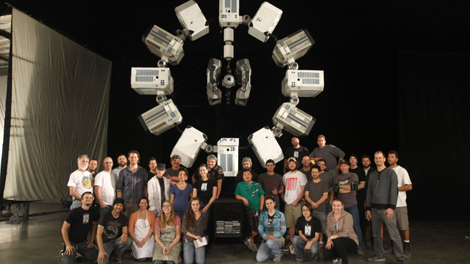
The CAD data was not only used to help build realistic props, but also to plan out the lighting and camera rigs, and to organise complex scenes in Interstellar
CG effects are responsible for vast amounts of movie screen time but what happens if the film director needs real spaceships?
This was the task faced by New Deal Studios when Interstellar director Christopher Nolan wanted the vehicles to feel like real spacecraft, a project that would involve a strange new workflow – taking movie CG effects and transforming them into physical surroundings.
Taking the CG models from Double Negative in London used for digital FX and the pre-visuals process, as well as designs from the production art department (used for full size and scaled sets), the team transformed these artistic 3D models into miniature scale models and props.

The CAD data was cleaned up and used to 3D print parts for the scale models used in filming
Most of the CAD data came from Autodesk Maya, and New Deal Studios converted it to FBX files and imported it into Modo.
This CAD data was broken down and prepped for all the parts of the different spacecraft – the Endurance, Lander, and Ranger.
It was important that the models were clean and accurate both for export to Rhino3D using the Modo Power SubD-NURBS plugin to generate build drawings, and for STL files for 3D printing.
Out of more than 100 motion control shots for the movie, a key scene in which a failed docking attempt with the Endurance causes a large scale explosion, proved one of the most complicated for New Deal.
It had been planned out in a Modo pre-visual as a large scale move with debris and chunks of spacecraft flying off into space.
Digital FX supervisor Jeff Jasper traced the motion path of the main chunks of ship breaking off in the explosion from the Modo pre-visual and, using those paths, he figured out how to orient the physical model in the studio so they could use gravity and a cable pull system to mimic the look of zero-gravity for all three cameras used for the sequence.

The work by New Deal Studio team helped win Interstellar the Oscar for best visual effects
An engineering assembly from Solidworks was used to build a virtual set, including New Deal’s backlot, building, steel truss rigging for the model, the Gradall (used to hold the rigging and model up), camera positions, and black screens. This way there was no guesswork when it came to how they were going to put together this highly complicated shot.
“The Foundry’s software not only gives us an end-to-end toolset but it plays well with third-party software, so we always have the flexibility to handle any challenge that gets thrown our way,” explains Jasper.
The end results were so impressive that they helped land Interstellar the Oscar for best visual effects – surely the biggest accolade for such an out-of-this-world task.






